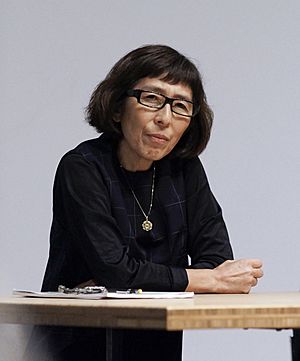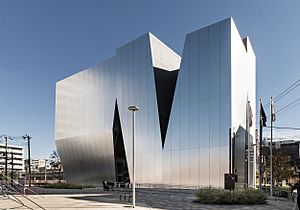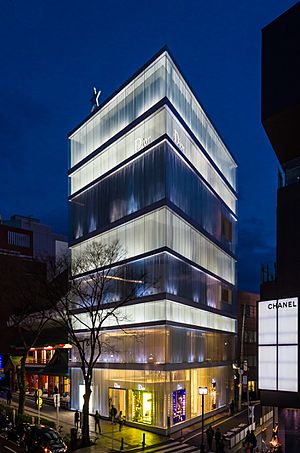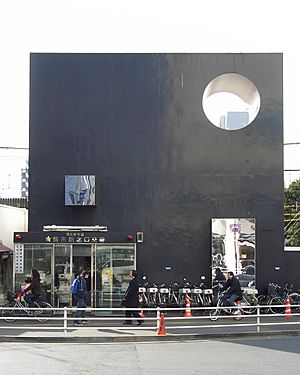Kazuyo Sejima facts for kids
Quick facts for kids
Kazuyo Sejima
|
|
|---|---|

Sejima in 2014
|
|
| Born | 29 October 1956 Hitachi, Ibaraki Prefecture, Japan
|
| Nationality | Japanese |
| Occupation | Architect |
| Awards | Rolf Schock Prize (2005) Pritzker Prize (2010) RIBA Royal Gold Medal (2025) |
| Practice | Kazuyo Sejima and Associates (1987–1995) SANAA (since 1995) |


Kazuyo Sejima (born October 29, 1956) is a famous Japanese architect. She leads her own architecture company, Kazuyo Sejima & Associates. In 1995, she also helped start another company called SANAA (which stands for Sejima + Nishizawa & Associates).
In 2010, Kazuyo Sejima made history. She became only the second woman ever to win the Pritzker Prize. This award is one of the highest honors an architect can receive. She shared the prize with her partner, Ryue Nishizawa. They were also only the second team to win this important award together.
Contents
Early Life and Education
Kazuyo Sejima was born in Mito, Ibaraki, Japan, on October 29, 1956. Her mother was very educated, and her father worked as a welding engineer.
Sejima studied hard and graduated from Japan Women's University in 1979. She then continued her studies and earned a Master's Degree in architecture in 1981. Right after finishing her studies, she started working at a well-known architecture firm called Toyo Ito and Associates. She worked there until 1987.
A Career in Architecture
After gaining experience with Toyo Ito, Kazuyo Sejima decided to open her own architecture firm in 1987. She named it Kazuyo Sejima & Associates. One of the first people she hired was Ryue Nishizawa. He was a student who had worked with her before at Toyo Ito's firm.
After several years, Sejima asked Nishizawa to become her partner. In 1995, they officially started their new company, SANAA, based in Tokyo. SANAA stands for Sejima and Nishizawa and Associates.
In 2010, Sejima was chosen for a very special role. She became the director of the architecture section for the Venice Biennale. This is a huge international art and architecture exhibition. She was the first woman ever to be selected for this important position. In the same year, she received the Pritzker Prize with Ryue Nishizawa, recognizing their amazing work.
Notable Buildings and Projects
Kazuyo Sejima and her firms have designed many unique and interesting buildings around the world. Here are some of her major projects:
- Saishunkan Seiyaku Women's Dormitory, Kumamoto, Japan (1990–1991)
- Gifu Kitagata Apartment, Gifu, Japan (1994)
- Multi Media Studio, Ōgaki, Gifu, Japan (1995)
- 'De Kunstlinie' Theatre and Cultural Centre, Almere, Netherlands (1998–2007)
- SANAA’s 21st Century Museum of Contemporary Art, Kanazawa, Japan (1999–2004)
- Glass Pavilion of the Toledo Museum of Art, Toledo, Ohio, USA (2001–2006)
- DIOR Tokyo Omotesando Store, Tokyo, Japan (2003)
- Zollverein School of Management and Design, Essen, Germany (2003-2006)
- Naoshima Ferry Terminal, Naoshima, Kagawa, Japan (2003–2006)
- New Museum of Contemporary Art, New York City, USA (2003–2007)
- Towada Art Center, Towada, Japan (2005–2008)
- Rolex Learning Center, École Polytechnique Fédérale de Lausanne (EPFL), Switzerland (2005–2009)
- Serpentine Pavilion at Serpentine Galleries, London, UK (2009)
- Louvre-Lens in Lens, France (2012)
- La Samaritaine in Paris, France (2020)
- Sydney Modern (extension of the Art Gallery of New South Wales), Australia (2022)
Awards and Recognitions
Kazuyo Sejima has received many awards for her outstanding work in architecture. These awards show how much her designs are appreciated around the world.
- 1989 – Special Prize for Residential Architecture, Tokyo Architecture Association
- 1990 – SD Prize, SD Review
- 1992 – Second Prize, Commercial Space Design Award
- 1995 – Kenneth F. Brown Asia Pacific Culture and Architecture Design Award, the University of Hawaii
- 2005 – Rolf Schock Prize in Visual Arts
- 2010 – Pritzker Prize
- 2019 – Prix Versailles World Judge
- 2022 – Praemium Imperiale award for architecture
- 2024 – Person of Cultural Merit
- 2025 – RIBA Royal Gold Medal for architecture
See also
 In Spanish: Kazuyo Sejima para niños
In Spanish: Kazuyo Sejima para niños




